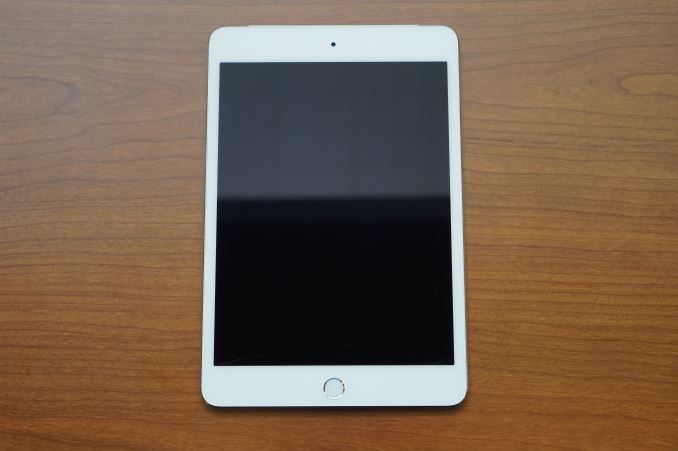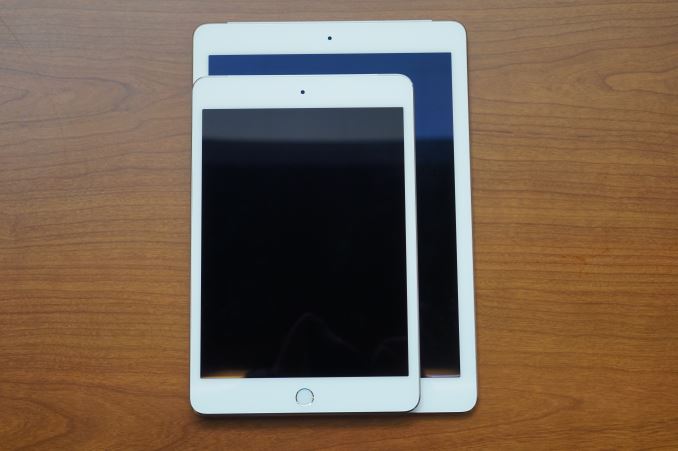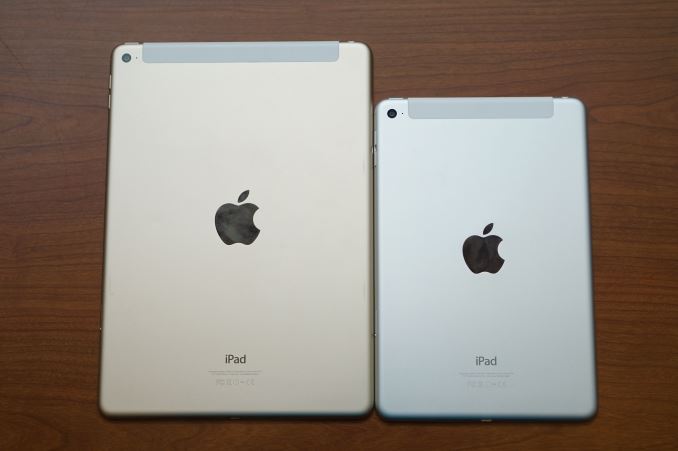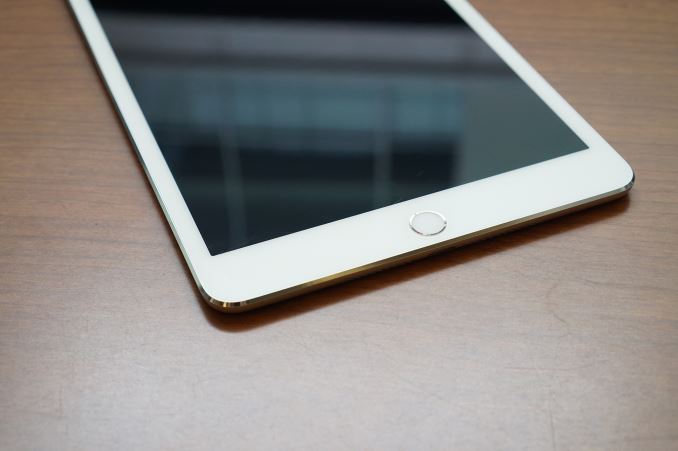The Apple iPad Mini 4 Review
by Brandon Chester on October 28, 2015 8:00 AM EST- Posted in
- Tablets
- Apple
- Mobile
- iPad Mini 4

For a while now Apple has been holding two launch events toward the end of each year. The first event in September is used to launch new iPhones, and new products and services like the Apple Watch and Apple Pay. In October Apple then has an event where the main focus is on new iPads, along with some other announcements such as new Macs or accessories. This year Apple appears to have switched up the formula, as they rolled both the iPhone and iPad announcements into a single September event. With October essentially over it looks like we won't be seeing any more Apple launch events this year, and new products like the iMac with 4K Retina display have had quieter soft launches which supports this theory.
Since Apple combined their iPhone and iPad events into one, we actually have a new iPad shipping earlier than they're usually even announced. The iPad Pro won't go on sale until November, and the iPad Air 2 didn't see an update, but the iPad Mini line got a significant overhaul in the form of the iPad Mini 4, and it has been available for well over a month at this point. The iPad Mini has definitely been in need of a significant upgrade for a while, with last year's iPad Mini 3 essentially just being the iPad Mini 2 with Touch ID. While there's more to a device than spec sheets, they can provide a high level view of how two devices compare to one another. You can view the specs of the iPad Mini 4 compared against those of the iPad Mini 3 in the chart below.
| Apple iPad Mini 3 | Apple iPad Mini 4 | Apple iPad Air 2 | |
| SoC | Apple A7 2 x Apple Cyclone @ 1.3GHz |
Apple A8 2 x Apple Typhoon @ 1.5GHz |
Apple A8X 3 x Apple Typhoon @ 1.5GHz |
| GPU | PowerVR G6430 | PowerVR GX6450 | Apple GXA6850 |
| RAM | 1GB LPDDR3 | 2GB LPDDR3 | |
| NAND | 16/64/128GB | ||
| Display | 7.9" 2048x1536 IPS LCD | 9.7" 2048x1536 IPS LCD | |
| Dimensions | 200 x 134.7 x 7.5mm, 331g | 203.2 x 134.8. x 6.1mm, 298.8g | 240 x 169.5 x 6.1mm, 437g |
| Camera | 5MP Rear-Facing, F/2.4 1.2MP Front-Facing, F/2.2 |
8MP Rear-Facing, F/2.4, 1.1 micron 1.2MP Front-Facing, F/2.2 |
|
| Battery | 23.8Wh | 19.1Wh | 27.3Wh |
| OS | iOS 9 | ||
| Cellular Connectivity | Optional MDM9x15 Category 3 LTE + GNSS | Optional MDM9x25 Category 4 LTE + GNSS | |
| Other Connectivity | 2x2 802.11a/b/g/n + BT 4.2, Apple Lightning | 2x2 802.11a/b/g/n/ac + BT 4.2, Apple Lightning | |
| SIM | Optional NanoSIM | ||
| Price | $399/499/599 WiFi, $529/629/729 LTE | $499/599/699 | |
When looking at the iPad Mini 4 on paper it looks very similar to Apple's iPad Air 2. There's a 2048x1536 IPS display, an 8MP rear-facing camera, 2x2 802.11ac WiFi, and 2GB of DRAM packed into a 6.1mm thick chassis. Of course, there is one major difference that can be seen from the specs, and that's the SoC. While the iPad Air 2 has Apple's A8X SoC, the iPad Mini 4 only has their A8 chip. This version of A8 does have bumps to the CPU and GPU frequency compared to the version that shipped in the iPhone 6, but it's missing the additional core of A8X and the GPU is Imagination Technologies' GX6450 rather than Apple's custom 8 core GXA6850.
There can also be differences between devices that don't show up in a spec sheet. For example, the iPad Mini 2 and the iPad Air were actually more similar on paper than the Mini 4 and Air 2 are. However, the specifications for the display didn't take into account the iPad Mini 2's limited color gamut, which was a major difference between the two devices. Ultimately, it's difficult to compare two devices just based on their specs, and over the course of the review I'll be looking the different aspects of the iPad Mini 4 in order to compare it to both the iPad Air 2 and the various other tablets that I've tested.
Design
Apple described the iPad Mini 4 as a shrunken down iPad Air 2, and as far as the design goes they really weren't kidding. If you were to shrink down the Air 2 and scale the mass appropriately you would get this chassis. Compared to the iPad Mini 3 it's 3.2mm taller, 0.1mm wider, and 1.4mm thinner. The difference in thickness is definitely noticeable, especially when holding it in one hand. The mass has also been reduced, dropping from 331 grams to 298.9 grams. 30 grams doesn't sound like a ton, but when you're holding a tablet in one hand it's definitely noticeable and helps to reduce fatigue when holding the Mini 4 for long periods of time.
There's really not a whole ton to say about the front of the iPad. It's a big display, with a single button that also hides a fingerprint scanner, and a 1.2MP front-facing camera at the top. The cover glass is a giant flat sheet, and it meets chamfered edges on all sides, although unlike most non-Apple devices the glass is elevated so that your finger doesn't catch on the edges as you swipe off the surface of the glass. This is more expensive, harder to manufacture consistently, and reduces drop protection, but I think it's one of the small details that can make a device much nicer to use than those that lack it. Something interesting is that the spectrum reflected by the glass is different than the glass used on the Air 2. While both tablets have the same anti-glare coating, the more purple-shifted reflections of the Air 2 actually make things slightly more readable when there are visible reflections on the display.
As for the back cover, there's also not much to say about it. The top left corner has Apple's 8MP rear-facing camera, in the middle is the Apple logo, and below that is the word iPad accompanied by various regulatory text that I continually hope can one day be banished and moved into a section of every device's settings application. On the cellular models you also get the plastic RF window at the top, which is white on the silver and gold models, and black on the space grey model. Beyond that it's just an unbroken piece of aluminum, and it feels as sturdy and solid as Apple's products usually do.
One thing worth noting for owners of older iPads is that the mute/rotation lock switch is no longer present. Like the iPad Air 2, that functionality has been moved into Control Center.
Something I've always noticed is that the industrial design of the iPad lags behind the iPhone by a couple of years. While the iPhone 5 was introduced with new industrial design (ID) with visual characteristics like chamfered bezel edges, the iPad 4 that launched the following month used the same tapered chassis as the iPad 3, and even retained the resin filling between where the display met the edges of the chassis. Interestingly enough, the iPad Mini that launched alongside the iPad 4 actually did match the ID of the iPhone 5 with some obvious concessions like the curved sides to maintain ergonomics. However, I think this was mostly a result of the iPad Mini being a completely new device rather than an interation of a previous one. With the iPad Air Apple brought the large iPad's ID mostly in line with the iPhone 5/5s, and it has stayed mostly the same in each subsequent Mini and full sized iPad while the iPhone has moved onto a newer design with curved glass that meets rounded edges. This isn't necessarily a bad thing, but I can't help but find myself imaging what the iPad Mini 4 would look like if it shared the ID of the iPhone 6/6s.
Ultimately, the design changes going from the iPad Mini 3 to the iPad Mini 4 are just those from the iPad Air to Air 2 transition but on a smaller device. The tablet gets thinner, lighter, and there are some design changes to go along with the thinner profile like only having a single row of speaker holes on the bottom of the chassis. It's worth noting that I didn't find these speakers to be any better or worse than the Air 2, and
If you've ever seen an iPad Air 2 you already know what an iPad Mini 4 looks like, because it's the same sturdy and premium feeling aluminum enclosure but made smaller. I would definitely like to see a new set of iPads that adopt the iPhone's most recent ID, but I'm not at all unhappy with the current state of the iPad's design. Apart from the Dell Venue 8 7840 there isn't really anything that is comparably well built at this price point, and so if you really care about the design and build quality of a tablet the iPad Mini 4 should be high up on your list of devices to consider.













98 Comments
View All Comments
Speedfriend - Wednesday, October 28, 2015 - link
Any idea why this uses the 8 and not the A8X? Does that imply the chassis is not capable of dissipating the higher TDP of the A8X?michael2k - Wednesday, October 28, 2015 - link
I imagine they would have needed a bigger battery to offset the performance cost of the faster GPU and additional CPU core. Throw in a bigger battery and you have to make the iPad a fractional bit thicker, maybe 0.7mm, and another 14g heavier.And throw those three changes (more expensive CPU, more expensive battery, heavier iPad) and you need to bump the cost up just slightly, reducing margins just slightly, on top of the changes in the display that already increase the cost, and it makes sense why they sacrificed performance slightly. This is especially true when the A8 is already and still class leading a year later.
ThomasS31 - Wednesday, October 28, 2015 - link
This has nothing to do with cost... its just a decision to keep everything as thin and light as possible to appeal to the fans and consumers.Ivy said not long ago, they could make a thicker iphone to last longer (battery), but they do not want as it will not appeal as much to the consumers as the current thin phones.
Nothing to do with cost or price... just a decision, some of us like, and some of us not. :)
michael2k - Wednesday, October 28, 2015 - link
None of the outward justification is cost, of course, but they have to hew to a budget like everything else in the world. They increased the cost of the SoC, the memory, the cameras, and the screen, as is. Throwing in the more expensive A8X, the battery for said A8X, and the thicker shell to support both means they would have, as you said, lose the design goal of thinner and lighter. So there would be three reasons to stick to the A8:1) Thinner
2) Lighter
3) Cheaper
GC2:CS - Thursday, October 29, 2015 - link
Considering how energy efficient the Apple chips are, het deffinitelly isn't a problem.You has A8, even if a bit underclocked in an 6,1mm iPod touch. There it can almost perfectly sustain it's peak 1,1 Ghz CPU clock and GPU performance. iPad mini is just a much bigger device, there is more than enough room to dissipate heat, even if it would mean an A8X has to throotle a bit more aggressively than in Air 2.
A8X is a three billion transistor monster, it's big, it's pricey and since it's an X there is no stacked memory on it. That might be the reason - all iPad minis used PoP to save space and so I think that a possibility of an X chip in any iPad mini is quite small.
Also it uses a quite lot of power. If you look at that Gfx bench battery life test above, maybe Apple wanted to match them in terms of battery life under load.
And then while mini might be cappable of dissipating enough heat, Apple possibly didn't wanted the temperatures to go that high. iPad mini 4 is found to be rather cool running even under load.
But I doo agree that an A9 would be much better match. Even though it doesn't have 128-bit memory interface (What has it by the way ?) it bassically matches the performance of A8X, while being much smaller and lower powered, much more efficient than even A8.
Apple said that it's an shrunken down iPad Air 2. In terms of battery life, features, design, cameras display yes.
But with smaller size (and less matter to built a tablet from) there has to be compromise somewhere. Apple didn't matched the performance of Air 2, because it would require more advenced tech (A9) to do so in smaller device. But that would make it more advanced than an shrunken down Air 2 in terms of used tech. Bassically they built the best small tablet possible with let's say the same genertion of technology as iPad Air 2.
iPad mini 2 got smaller color gamut, iPad mini 4 got lower performance. And unless Apple invents a way to make those devices bigger from the inside, they can't defy physics.
Pneumothorax - Thursday, October 29, 2015 - link
Here's the thing, the A9 would've been an easy drop in the Mini 4 and would've matched/exceeded the Air 2 in most benchmarks along with giving better battery life and much less heat. Apple is just being Apple - milking the cow for all it's worth.NetMage - Saturday, October 31, 2015 - link
The mini's considerable price drop versus the Air or phone means giving up something.Drumsticks - Wednesday, October 28, 2015 - link
Thanks for the review. I always enjoy reading Anandtech reviews of Apple products. While I'm an Android/Microsoft guy (any hints on when to expect your 6P review? I'm sure it's a ways off but I'd love a hint!), I have a lot of respect for Apple's hardware engineering and SoC design teams. They do really, really great work, and it almost disappoints me that I dislike iOS (and to an extent, Apple. This is an opinion that is fully subjective and not looking to start a fight! There's plenty of reasons to like Apple).Apple has, for the last several years been a major driver of innovation in the whole industry, which is great. It's awesome to see (in my opinion) both Microsoft AND Google doing the same nowadays. All three of the big guys are driving the industry forward, and it's good for us all :D
amdwilliam1985 - Thursday, October 29, 2015 - link
Same here, I recommend Apple products to others(my parents and my brother all use iPhones), but when it comes to personal device, I'll go with Android/Nexus, will be picking up a Nexus 6P soon, when it's available in Hong Kong.ps: Personally, I want to support Google/Alphabet, don't want to give my money to Apple and then have it sit in their bank doing nothing(besides earning interests ;). It's just a personal believe, I believe with great power comes great responsibilities(Apple should be doing more to help the [tech] world). Luckily, there are always companies like Google who pushes on with crazy projects like Project Loon, Project Fi, Project Soli, Project Jacquard and etc...
I watch Apple WWDC and Google IO live every year, Google's event is just so much more exciting and inspiring to the tech geek in me. Apple's show is more about how they are the best and if you can't join them, then you're a loser kind of show, lol.
Knowing my money helps Google to help improving the world/tech helps me sleep better at night, lol.
lucam - Wednesday, October 28, 2015 - link
The A8 is still a good decent Soc from what I can see and I have a suspicion that in the Apple TV for not having similar thermal constrains and no battery it can go even faster...